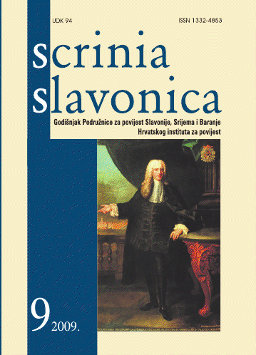Borba Pečuške biskupije za crkvenu desetinu u Slavoniji od oslobođenja od osmanske vlasti do 1761.
The struggle of the Diocese of Pécs for the Church’s tithe in Slavonia from the end of the Ottoman rule to 1761
Author(s): Milan VrbanusSubject(s): History
Published by: Hrvatski institut za povijest
Keywords: Diocese of Pécs; church tithe; Slavonia; Charles’ Urbarium; Maria Theresa’s Urbarium.
Summary/Abstract: The organization of the chamber administration in Slavonia began after Slavonia’s liberation from the Ottoman rule in 1961. At first the organization of chamber administration proceeded at a slow pace, since the war with the Ottoman Empire was still in progress and the military needs were given precedence. After the Christian army won the Battle of Senta in 1697, the organization of chamber administration in Slavonia sped up and the chamber commission with Count Carl Ferdinand Caraffa di Stigliano at the helm was sent to Slavonia. At the same time the establishment of church organization began in this territory, resulting in a clash between the Diocese of Zagreb and the Diocese of Bosnia over the Slavonian parishes, which ended in 1699 with the decision of the court commission in Györ that fixed the border between the two dioceses. The Diocese of Pécs got involved in the battle for Slavonian parishes only after the Györ trial, even though it had the greatest right to them. The Court Chamber, on the other hand, felt the tithe to be the state’s income, since Slavonia was conquered by arms. Chamber officials thus started collecting the tithe after the liberation from the Ottoman rule and transporting it to storehouses in Osijek, Brod, and Gradiška. In the 1720s the Bishop of Pécs managed to assert his right to collect the Great Tithe in Slavonia. After the peasant uprising in Slavonia was quelled in 1735, the Court in Vienna sent Hamilton’s commission to Slavonia to identify the causes of the uprising and suggest solutions to the problems they find.Tithe collection was one of the important problems. A conference was convened in Vienna in 1737, concluding that the Slavonian manor lords had no right to collect the tithe, while the bishops were entitled to collect the Great Tithe, but not the Little Tithe. King Charles III (VI) prohibited the manor lords from collecting the tithe and allowed the bishops to collect the Great Tithe, forbidding them to collect the Little Tithe before they proved their right to this tax. In spite of the regulation on the church tithe by Charles’ Urbarium, the Bishop of Pécs strove to gain the right to collect the little tithe as well. A temporary Slavonian urbarium again forbade the bishops to collect the little tithe until they proved their right to this tax. The issue of tithe collection was only solved in 1761 at a meeting of manor representatives and bishops, where they reached an agreement about tithe collection rights.
Journal: Scrinia Slavonica
- Issue Year: 2009
- Issue No: 9
- Page Range: 430-464
- Page Count: 35
- Language: Croatian

